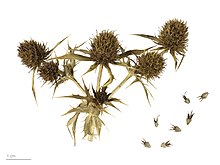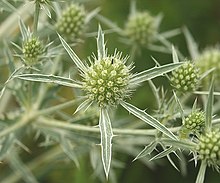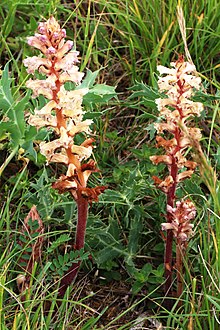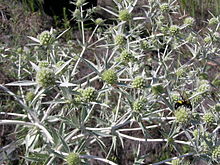Field man litter
| Field man litter | ||||||||||||
|---|---|---|---|---|---|---|---|---|---|---|---|---|

Field man litter ( Eryngium campestre ) |
||||||||||||
| Systematics | ||||||||||||
|
||||||||||||
| Scientific name | ||||||||||||
| Eryngium campestre | ||||||||||||
| L. |
The field man litter ( Eryngium campestre ) is an umbelliferae (Apiaceae) that occurs frequently or rarely in Central Europe . Other, sometimes regionally used or outdated names are: Donnerdistel, Krausdistel, Gemeine Brachdistel, Rolldistel, Radendistel, Elend, Unrest.
description
The perennial herbaceous plant reaches a stature height of 15 to 60 cm, but can occasionally reach 1 m. It is gray to yellowish-green in color and sparsely branched. The first leaves are undivided and elongated in shape, the later ones are palmate-pinnate to double-pinnate or threefold, double-pinnate and toothed. The lower ones are stalked, the upper ones encompassing the stems.
The umbels are numerous, dense and from hemispherical to cylindrical shape and have numerous, linear bracts . The flowers are close together. The inflorescence has numerous bracts that protrude from the umbels. The crown is colored white or gray-green. The fruit is flaky.
Flowering time is July and August.
The number of chromosomes is 2n = 14 or 28.
ecology
The field man litter is a perennial hemicryptophyte (half-rosette plant), a deep-rooted (the cylindrical-spindle-shaped rhizome roots up to 2 m deep), a xerophyte with hardly wilting thorny leaves. The many thorns protect the plant from damage caused by grazing animals. In a few places in Germany there is the amethyst summer root, which parasitizes on field man litter.
The flower umbels are united to form a cephalic inflorescence analogous to the inflorescence of the daisy family . These are nectar- bearing "cup flowers". The flower heads are surrounded by thorny bracts. Stiffly upright sepals form "small funnel flowers". In relation to the total inflorescence , the flowers are distributed andromonözisch: the umbels of the first to third order usually only have hermaphrodite flowers, the umbels of the fourth order mostly only small male flowers. The hermaphroditic flowers are pre-male.
The nectar is only accessible to insects with a proboscis at least 2 mm long, e.g. B. Bees and butterflies. Flies only eat the pollen .
The plants are typical “floor rollers” ( Chamaechorie strategy): When ripe, the shoots are torn off at a predetermined breaking point at the root ball at wind speeds of at least 4 m / s and then rolled away as a whole, the fruits being gradually scattered . If several plants get stuck, more or less large "steppe witches" arise, as they are often meters high - especially for Eastern European steppes - characteristic. It also spreads as wind and animal spreaders (Velcro fruits). The fruits are light and frost germs.
Occurrence
General distribution
The field man litter occurs from North Africa, Southern Europe and Eastern Europe to Central Europe, also in the Caucasus region and to Iran and Afghanistan. It is a European-continental-Mediterranean-sub-Mediterranean floral element .
Distribution in Central Europe
Eryngium campestre occurs absent-mindedly to widespread, especially in the Elbe and Rhine valleys ( Großer Sand (Mainz) ) and in the Main region. Otherwise it is rare. In northern Germany, the Alps and the Bavarian plateau, it is only sporadic or absent.
In Austria it is moderately common in the Pannonian region , otherwise rarely to be found. The deposits extend to the federal states of Vienna , Lower Austria , Burgenland and Upper Austria . In Styria and Tyrol only inconsistent occurrences are known, in Carinthia and Salzburg the species is extinct. In the northern foothills of the Alps, field litter is considered endangered.
In Switzerland it occurs rarely and mainly in the southwestern part.
Location
The field man litter settles scattered in sunny, lime, lean lawns and pastures and on paths and embankments. It prefers dry soils in warm places in summer.
According to Ellenberg , it is a full-light plant, a warmth indicator, intermediate continental distribution, a drought indicator, growing on low-nitrogen locations and a class character of the limestone grasslands (Festuco-Brometea). But it also occurs in societies of the order Agropyretalia.
Pharmacology, ingredients
For the root and the herb, saponins and a little essential oil are stated as ingredients. The root is said to have a low expectorant and spasmolytic (anticonvulsant) effect, the herb a (weak) diuretic effect. In earlier times the root was also used to make supposedly diuretic and menstrual drugs. There is no scientific evidence of its effectiveness, but a calming, cough-relieving and anticonvulsant effect on whooping cough has been described (for flat-leaf man litter ). Nothing is known about adverse effects.
Species protection
- The field man litter is specially protected according to the Federal Species Protection Ordinance .
- The rare amethyst summer root ( Orobanche amethystea ) parasitizes on Eryngium campestre . The species is threatened with extinction in Baden-Württemberg.
Common names
For the field man litter, the other German-language common names exist or existed : Brachdistel, Brachendistel, Brackendistel, Braundistel, curled thistle, ummelopen thistle ( Middle Low German ), valende thistle, whale thistle, flowing thistle, flowing thistle morch ( middle high German ), wilt thistle wolt Distel, Donnerdistel ( Wittenberg ), Edeldistel, Elend (Middle High German), Ellendistel (Middle High German), Ellend, Fechdistel ( Old High German ), Fehdistel (Old High German), Fychdistel (Old High German), Gruntwurz, Hundertistel, Hauptkopf, Krauswistel , Running thistle, Mannertreu, Mannstreu, Mannstreu-Thistel, Mansstrü, Martsdistel (Middle High German), Mehrdistel, Merdistel, Mörwurzel, Mordwurz, Mortdistel (Middle High German), Mortedistel (Middle High German), Oerengel, Ore Engel, Orengelack, Orengele (Middle High German), Prussian root , Raddistel, Radendistel, Rodendistel, Schmänkkrokt ( Transylvania ), special bark, stinging root, standing root, Stradistel, Unruh ( Linz ), Valentdistel, Veherdistel (Middle High German), Veltdistel (Middle High German), Wallendistel, Waltdistel (Middle High German) and Woltdistel (Middle High German).
history
swell
- Antiquity - late antiquity: Dioscorides 1st century - Pliny 1st century - Galen 2nd century - Pseudo-Dioscorides de herbis femininis . 6th century
- Arab Middle Ages: Pseudo-Serapion 13th century - Ibn al-Baitar 13th century
- Latin Middle Ages: Herbarius Moguntinus 1484 - Gart der Gesundheit 1485 - Hortus sanitatis 1491 - Hieronymus Brunschwig 1500
- Modern times: Otto Brunfels 1532 - Hieronymus Bock 1539 - Leonhart Fuchs 1543 - Mattioli / Handsch / Camerarius 1586 - Nicolas Lémery 1699/1721 --- Onomatologia medica completa 1755 --- Hecker 1814/15 - Pereira / Buchheim 1846/48
Historical illustrations
Vienna Dioscurides 6th century
Pseudo-Dioscurides de herbis femininis manuscript 14th century
Herbarius Moguntinus 1484
Garden of Health 1485
Hortus sanitatis 1491
Otto Brunfels 1532
Leonhart Fuchs 1543
Hieronymus Bock 1546
Mattioli / Handsch / Camerarius 1586
Individual evidence
- ↑ a b E. Winkler: Real-Lexikon der medicinisch-pharmaceutischen natural history and raw goods. Volume I, Leipzig 1840
- ↑ a b c Erich Oberdorfer : Plant-sociological excursion flora for Germany and neighboring areas . With the collaboration of Angelika Schwabe and Theo Müller. 8th, heavily revised and expanded edition. Eugen Ulmer, Stuttgart (Hohenheim) 2001, ISBN 3-8001-3131-5 , pp. 699 .
- ↑ name = "Oberdorfer2001"
- ^ Eryngium in the Germplasm Resources Information Network (GRIN), USDA , ARS , National Genetic Resources Program. National Germplasm Resources Laboratory, Beltsville, Maryland. Retrieved May 27, 2018.
- ^ Manfred A. Fischer, Karl Oswald, Wolfgang Adler: Excursion flora for Austria, Liechtenstein and South Tyrol . 3rd, improved edition. Province of Upper Austria, Biology Center of the Upper Austrian State Museums, Linz 2008, ISBN 978-3-85474-187-9 , p. 837 .
- ^ Rudolf Fritz Weiss: Textbook of Phytotherapy. 5th edition Stuttgart 1982, p. 245.
- ^ Georg August Pritzel , Carl Jessen : The German folk names of plants. New contribution to the German linguistic treasure. Philipp Cohen, Hannover 1882, page 145. ( online ).
- ↑ Pedanios Dioscurides . 1st century: De Medicinali Materia libri quinque. Translation. Julius Berendes . Pedanius Dioscurides' medicine theory in 5 books. Enke, Stuttgart 1902, p. 275: (Book III, Chapter 21): Eryngion (digitized version )
- ↑ Pliny the Elder , 1st century: Naturalis historia Book XXII, Chapter VIII (§ 18–23): Eryngion (digitized version ) ; Translation Külb 1855 (digitized version )
- ↑ Galen , 2nd century De simplicium medicamentorum temperamentis ac facultatibus , Book V, Chapter VII / 6 (based on the Kühn 1826 edition, Volume XI, p. 884): Eryngium (digitized version)
- ↑ Pseudo-Dioscorides de herbis femininis . 6th century edition: HF Kästner. Pseudo-Dioscorides de herbis femininis. In: Hermes , Vol. 31 (1896), Chapter 53: Eryngion (digitized)
- ^ Pseudo-Serapion 13th century, print. Venice 1497, sheet 112r (No XCVI): Astraticon. Iringi (digitized version )
- ↑ Abu Muhammad ibn al-Baitar , 13th century, Kitāb al-jāmiʿ li-mufradāt al-adwiya wa al-aghdhiya. Translation. Joseph Sontheimer under the title Large compilation on the powers of the well-known simple healing and food. Hallberger, Stuttgart, Volume II 1842, pp. 287–290: Karsannat (digitized version )
- ↑ Herbarius Moguntinus , Mainz 1484, Part I, Chapter 76: Iringus (digitized version )
- ↑ Gart der Gesundheit . Mainz 1485, chapter 429: Yringus. Kruß thistle (digitized version )
- ↑ Hortus sanitatis 1491, Mainz 1491, part, chapter 518: Yringus (digitized version )
- ↑ Hieronymus Brunschwig : Small distilling book , Strasbourg 1500, sheet 77v – 78r: Manß trü (digitized version )
- ^ Otto Brunfels : Contrafayt Kreüterbůch . Johann Schott, Strasbourg 1532, p. 282: Mannstrew (digitized version)
- ↑ Hieronymus Bock : New Kreütter Bůch . Wendel Rihel, Strasbourg 1539, part II, chapter 114 (incorrectly referred to as chapter 140): Manstrew (digitized version )
- ^ Leonhart Fuchs : New Kreütterbuch… Michael Isingrin, Basel 1543, Chapter 112: Manßtrew (digitized version )
- ^ Pietro Andrea Mattioli : Commentarii, in libros sex Pedacii Dioscoridis Anazarbei, de medica materia. Translation by Georg Handsch, edited by Joachim Camerarius the Younger , Johan Feyerabend, Franckfurt am Mayn 1586, sheet 228r – 229r: Manßtrew (digitized)
- ↑ Nicolas Lémery : Dictionnaire universel des drogues simples. , Paris 1699, p. 288: Eryngium (digitized version) ; Translation. Complete material lexicon. Initially drafted in French, but now after the third edition, which has been enlarged by a large [...] edition, translated into high German / By Christoph Friedrich Richtern, [...]. Leipzig: Johann Friedrich Braun, 1721, Sp. 436: Eryngium (digitized)
- ↑ Albrecht von Haller (editor): Onomatologia medica completa or Medicinisches Lexicon which explains all names and artificial words which are peculiar to the science of medicine and the art of pharmacy clearly and completely [...]. Gaumische Handlung, Ulm / Frankfurt am Main / Leipzig 1755, Sp. 611–612: Eryngium (digitized version )
- ↑ August Friedrich Hecker 's practical medicine theory. Revised and enriched with the latest discoveries by a practicing doctor . Camesius, Vienna, Volume II 1815, p. 76: Radix Eryngii (digitized version )
- ↑ Jonathan Pereira’s Handbook of Medicines Doctrine. From the point of view of the German Medicin edited by Rudolf Buchheim . Leopold Voss, Leipzig 1846-48, Volume II 1848, p. 539: ... Faithful to men, the roots of which are preserved with sugar ... (digitized version )
literature
- Henning Haeupler, Thomas Muer: picture atlas of the fern and flowering plants of Germany . Ed .: Federal Agency for Nature Conservation (= The fern and flowering plants of Germany . Volume 2 ). Eugen Ulmer, Stuttgart (Hohenheim) 2000, ISBN 3-8001-3364-4 .
- Wolfgang Adler, Karl Oswald, Raimund Fischer: Excursion flora of Austria . Ed .: Manfred A. Fischer. Eugen Ulmer, Stuttgart / Vienna 1994, ISBN 3-8001-3461-6 .
- Christian Heitz: School and excursion flora for Switzerland. Taking into account the border areas. Identification book for wild growing vascular plants . Founded by August Binz. 18th completely revised and expanded edition. Schwabe & Co., Basel 1986, ISBN 3-7965-0832-4 .
- Erich Oberdorfer : Plant-sociological excursion flora . With the collaboration of Theo Müller. 6th, revised and expanded edition. Eugen Ulmer, Stuttgart (Hohenheim) 1990, ISBN 3-8001-3454-3 .
- Konrad von Weihe (ed.): Illustrated flora. Germany and neighboring areas. Vascular cryptogams and flowering plants . Founded by August Garcke. 23rd edition. Paul Parey, Berlin / Hamburg 1972, ISBN 3-489-68034-0 .
- Heinz Ellenberg : Vegetation of Central Europe with the Alps in an ecological, dynamic and historical perspective (= UTB for science. Large series . Volume 8104 ). 5th, heavily changed and improved edition. Eugen Ulmer, Stuttgart (Hohenheim) 1996, ISBN 3-8252-8104-3 .
- Margot Spohn, Marianne Golte-Bechtle: What is blooming there? The encyclopedia: over 1000 flowering plants from Central Europe. Kosmos, Stuttgart 2005, ISBN 3-440-10326-9 .
- Ruprecht Düll , Herfried Kutzelnigg : Pocket dictionary of plants in Germany. A botanical-ecological excursion companion to the most important species . 6th, completely revised edition. Quelle & Meyer, Wiebelsheim 2005, ISBN 3-494-01397-7 .
- Siegmund Seybold (Ed.): Schmeil-Fitschen. Interactive flora of Germany. Seeing - determining - knowing. The key to the flora . CD-ROM, version 2.0. Quelle & Meyer, Wiebelsheim 2004, ISBN 3-494-01368-3 .
- Dietrich Frohne: Medicinal Plant Lexicon . A scientifically based guide. 7. completely rework. Edition. Scientific publishing house, Stuttgart 2002, ISBN 3-8047-1897-3 .
- Tobias Jesske: Geobotanical and population genetic studies on Eryngium campestre. AG for Vegetation Ecology and Experimental Plant Sociology, TU Braunschweig, PDF file .
Web links
- Field man litter. In: FloraWeb.de.
- Profile and distribution map for Bavaria . In: Botanical Information Hub of Bavaria .
- Field man litter . In: BiolFlor, the database of biological-ecological characteristics of the flora of Germany.
- Eryngium campestre L. In: Info Flora , the national data and information center for Swiss flora . Accessed December 31, 2015.
- Distribution in the Netherlands [1] (Dutch)
- Horticulture:
- Photos:
- Botanical Garden of the Ruhr University Bochum ( Memento from September 22, 2011 in the Internet Archive )
- Bochum Botanical Association













